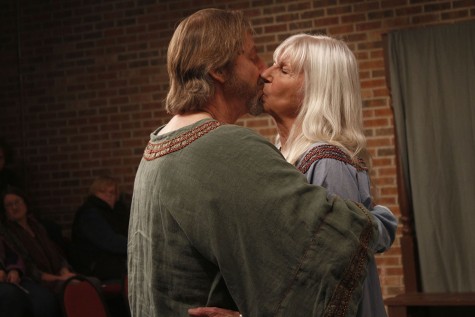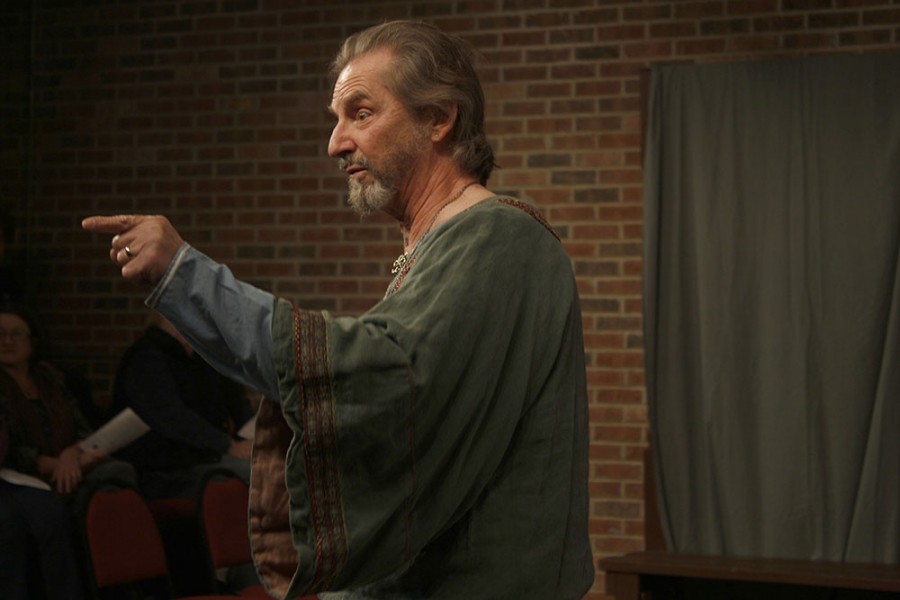Charleston Alley Theatre shows emotional range in ‘The Lion in Winter’
Henry II, played by Duke Bagger, tries to win the fight of who will be crowned king in the play “The Lion in Winter” on Friday at the Charleston Alley Theater.
March 29, 2015
Mixing the drama of three sons fighting to inherit their father’s throne with swift lines of humor and a tense build-up of character conflicts, The Charleston Alley Theatre succeeded to put on a lively rendition of “The Lion in Winter” Friday.
While the theater’s limited set left much of the scenes to the imagination, the actors, especially Duke and Linda Bagger playing the roles of feuding husband and wife King Henry II and Eleanor of Aquitaine, brought the story to life with a realistic portrayal of the anger, love and chaos of a complex relationship.
The story itself was sure to have drawn audiences in during this weekend’s performances as well, as it contains universal themes like jealousy and power struggles common in Shakespeare plays and even inspired the TV show “Empire.”
James Goldman’s 1966 play takes place in 1183 and gives a glimpse into the life of King Henry II of England, who considers eloping with his mistress in the hopes of having new sons to offer his kingdom to.

Henry II, played by Duke Bagger, and Eleanor of Aquitaine, played by Linda Bagger, share a kiss as a way of settling their differences in the play “The Lion in Winter” on Friday at the Charleston Alley Theater.
He had four sons with his wife, Eleanor of Aquitaine, but the eldest has died, and the three other sons each have disappointed him or lost his trust.
The oldest son Richard (Jeffrey Augenstein) had moments of shifting anger as arguments commenced over which son truly deserves the crown, though the raising of his voice did not seem to convey the exact passion the scenes demanded.
However, his redeeming moment was when Henry lunges at his three sons with a sword threatening to kill them, and Richard matches his father’s attack with an intense, unflinching stare as his brothers cower behind him.
Another moment of strong emotion occurs when Eleanor challenges Henry to kiss his lover, Alias (Rachael Anderson), who was betrothed to marry Richard, so she could observe for herself if they really loved each other.
The short embrace was believable and conveyed a sense of longing and desire.
The most humorous part was when King Phillip of France (Kent Wolf), who was also Alias’ half-brother, allows the three sons to hide in his room as he questions Henry about his plans for passing on the crown.
Just as he reveals favor for one son or the other, each of them emerge from hiding, and Henry’s obvious frustration is portrayed in a way that was both funny and allowed the audience to better understand his conflict.
Eleanor has great moments as well; for example, she goes back and forth with being compassionate to Henry and enraged with him, while both are equally convincing. She also has dynamic interactions with her sons as she attempts to help them escape prison and disputes ensue over whether or not she wanted them to kill their father and how she wasn’t there to care for them like a typical mother.
The development of the king and queen’s relationship is the best part of the play. While the main conflict seems to be about who will inherit the throne, the resolution is more centered on how the couple comes to terms with how they have failed at life and their relationship.
The small size of the CAT’s stage limited the scene setting, as small wooden tables and chairs were the majority of the furniture.
However, this could also be seen as a plus, because it allowed the audience to focus in more on the actors themselves, who did a good job of making a classic story engaging with realistic emotions.
Stephanie Markham can be reached at 581-2812 or samarkham@eiu.edu.





































































